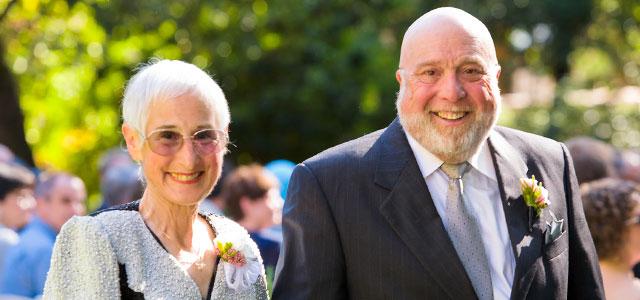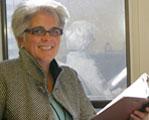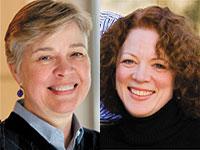
Janet and Joel Panzer
Dementia’s Hidden Toll: Helping Family Caregivers Cope
A few years after Janet Panzer, a San Francisco middle school teacher, retired, her personality changed. After a lifetime prone to depression, at age 59 she seemed less stressed, happier, says her husband, Joel. She attributed her recovery from depression to her retirement.
He was pleased when, after he retired, she suggested they buy a boat. He was also surprised. “We’d had two, and she hated them. I couldn’t get her to go out on them,” says Joel.
Janet’s response to his surprise was perhaps prophetic: “People can change,” she told him.
Joel didn’t realize that the sudden about-face was the harbinger of something more than a pleasant reduction in stress. “Why would I want to investigate any further?” he says. “I was happy with the ‘new woman’ in my life. I had a partner, a friend: we were doing things together.” They took a bucket-list cruise through the Panama Canal. And then, he says, things started to come unraveled.
Things went well over the next few years, but by 2010 the changes in Janet grew ominous. She began to insinuate herself into strangers’ conversations; she lost touch with things that had been everyday aspects of her life; she began to have an insatiable craving for sweets, often stopping in at businesses on her daily walk to avail herself of the candy jars some kept on their counters.
Although Joel and Janet didn’t realize it then, these were symptoms of frontotemporal dementia (FTD), a disorder caused by degeneration in the frontal or temporal lobes of the brain (or both). It causes progressive changes in an individual’s behavior, communication skills and, eventually, movement and the ability to care for oneself.
While FTD is less common than some other types of dementia, such as Alzheimer’s disease, it is difficult to get an accurate picture of just how many people have FTD because it is often misdiagnosed. “The behaviors that come along with FTD don’t always make people think of dementia,” says Margaret Wallhagen, director of the UCSF/John A. Hartford Center of Gerontological Nursing Excellence. “Memory isn’t usually the first problem, so family members [tend to] think of mental health issues.”
Eventually, a neuropsychiatric evaluation revealed what Joel had feared: Janet had experienced a significant decrease in her cognitive functioning, which was likely due to what the physician believed at the time was Alzheimer’s disease but was eventually determined to be a type of FTD (there are several variants) known as primary progressive aphasia (PPA), which reduces an individual’s capacity to speak and understand words, and recognize familiar people and things. What scared Joel the most, he says, is that Janet had no reaction to the news. “It was like she didn’t hear it.” This was the beginning of a new role for Joel: family caregiver. He left the property management company he had spent 30 years building in order to care for Janet.
The Challenges of FTD Caregiving
 Cindy Wong The behavioral problems associated with FTD can be particularly difficult for caregivers, says Cindy Wong, a nurse who has studied family caregivers at the UCSF Memory and Aging Center and who received her PhD from UC San Francisco School of Nursing in 2012. “Socially unacceptable behaviors, changes in food preferences, particularly for sweets and carbohydrates, and impulsiveness are common,” says Wong. She cites patients with FTD who never gambled before losing money in online casinos.
Cindy Wong The behavioral problems associated with FTD can be particularly difficult for caregivers, says Cindy Wong, a nurse who has studied family caregivers at the UCSF Memory and Aging Center and who received her PhD from UC San Francisco School of Nursing in 2012. “Socially unacceptable behaviors, changes in food preferences, particularly for sweets and carbohydrates, and impulsiveness are common,” says Wong. She cites patients with FTD who never gambled before losing money in online casinos.
Several studies, including Wong’s, have found that caregivers of people with FTD, particularly the variant in which behavioral symptoms are prevalent, often experience more distress and worse mental health outcomes than do caregivers of those with other types of dementia.
FTD is also challenging because of who it strikes. It differs from Alzheimer’s disease and other types of dementia in that it tends to occur in younger people, most commonly those between the ages of 45 and 65. The decline of a spouse, partner or parent at what is normally a time of relative health and independence can be particularly hard. Wong says, “People may be at the peak of their careers when they start to exhibit signs of FTD. The unexpectedness of the situation can affect the families in many ways and can certainly affect caregiver burden.”
Unlike early Alzheimer’s, in which people can be very sociable, the behavior changes that can affect people with some types of FTD, which can be socially awkward and embarrassing, can cause caregivers to withdraw from social activities, leaving them particularly isolated, says Wallhagen. Joel Panzer echoes this, describing an early support group he attended in which other caregivers, whose loved ones largely had Alzheimer’s disease, talked about activities he could only dream of. “They had stories about trips to Tahoe or Paris,” he says. “Their wives were still high functioning after years with Alzheimer’s. My wife was already half gone and sliding even further.” Like many people with FTD, Janet was experiencing a rapid progression of her disease; the average time from diagnosis to death is 3.5 to 6 years in FTD, compared with 7 to 10 years for a person diagnosed with Alzheimer’s in his or her 60s or early 70s.
The apathy and lack of emotional responsiveness – the blunted aspect that shocked Joel Panzer – is a characteristic feature of the disease, and is often one of the hardest things for family caregivers to cope with, says Wallhagen, who worked with Wong on her research. “It is like a loss of contact for caregivers,” she says.
Dealing with Loss and Change
 Robin Ketelle Loss is a common theme among caregivers for people with any form of dementia, says Robin Ketelle, a gerontological nurse at the Memory and Aging Center, who has been working with dementia patients and caregivers since 1982. She currently manages several research projects on dementia and runs a support group for caregivers of people with FTD.
Robin Ketelle Loss is a common theme among caregivers for people with any form of dementia, says Robin Ketelle, a gerontological nurse at the Memory and Aging Center, who has been working with dementia patients and caregivers since 1982. She currently manages several research projects on dementia and runs a support group for caregivers of people with FTD.
“With dementia, the person’s selfhood is being compromised,” she says. “The relationship is changing drastically, and people are grieving all of these different losses – loss of the relationship, loss of function, loss of the person themselves.” Many of the people in Ketelle’s support groups experience what she calls “anticipatory grief” at the knowledge that the decline is inexorable.
As Panzer describes it, “The boat is constantly moving; all you can do is try to steer it a little, but you know where it’s going to end up.”
One of the most significant adjustments he had to make was the decision to place Janet in a residential facility. She had been in day care programs several days a week, but after a year, her condition had deteriorated to the point where she could no longer be left alone, and Joel realized that she was not safe at home. “One night I found her in the kitchen with a package of Splenda – she had shredded it with her teeth. I had no idea where she had gotten it. You can childproof a house, but what can you do with an adult?” he says.
It was a painful time for Joel and his two adult sons. They searched for and found a good residential facility for Janet, not far from the Noe Valley (San Francisco) home the family had shared for many years. “It was beautiful,” Joel says, “a gift.” They prepared carefully for the move, making sure her room was set up with her things from home, and writing letters for the staff to give to her if she became confused or upset after they had left.
When the day for the move came, Joel says, Janet displayed little emotion, but he was wrung out. “It was like leaving your child at day care for the first time,” he says. “I thought I could keep on taking care of Janet. It was hard to step back and say, ‘I’m losing control.’”
Supporting Caregivers
Although the options for treating most dementia remain limited, there is a role for health care providers in ensuring that both patients and caregivers get the help and support they need. At the UCSF Memory and Aging Center, caregivers are considered secondary patients. “You have to check in with them and see where they are emotionally and physically,” says Ketelle. “Often, they’re so focused on the caregiving role that they’re not even aware of their own needs. They’re surprised by others being concerned about them.”
 Linda Fodrini-Johnson Linda Fodrini-Johnson, a licensed family therapist and certified care manager and founder and director of the Eldercare Services care management agency in Walnut Creek, encourages caregivers to make self-care a priority. She says, “I tell clients, ‘You love to golf – go at least once a week. Have lunch with the people you golf with. Find a companion.’”
Linda Fodrini-Johnson Linda Fodrini-Johnson, a licensed family therapist and certified care manager and founder and director of the Eldercare Services care management agency in Walnut Creek, encourages caregivers to make self-care a priority. She says, “I tell clients, ‘You love to golf – go at least once a week. Have lunch with the people you golf with. Find a companion.’”
Support groups can also provide tremendous benefits, she says, not only because it can be helpful to share experiences, but also because members can give one another permission to take care of themselves. She recounts the story of one woman who went away for a monthly spa weekend. “When she came back and talked about how it gave her her life back, it gave everyone else permission, and we started hearing more of those kinds of stories.”
In addition to emotional support, caregivers need practical help with the challenges presented by a role that many of them never expected to fulfill and that may not come naturally. “Nurses out in the community can do a lot to help family caregivers. They use their expertise to guide families through the process and foster the resources that are needed, whether it’s for respite care, in-home care, placement services or liaison with the physician,” says Ketelle.
“I’d love to see every family who gets a dementia diagnosis get some direction to find resources,” says Fodrini-Johnson. Geriatric care managers – often nurses or social workers – can serve as guides and coaches, helping families create plans and avoid crises. Unfortunately, Medicare and Medicaid rarely cover care management services, and long-term care insurance may or may not. Families can expect to pay around $150 per hour for care management services in the Bay Area, says Fodrini-Johnson, but even a single hour, in which a care manager can point families to resources and entitlements, can be useful and help save money down the line.
There are also no-cost resources. Fodrini-Johnson conducts free classes for caregivers, and organizations like the Alzheimer’s Association and the Family Caregiver Alliance provide “fabulous services,” she says.
The Benefits of Caregiving
Despite the challenges, not every aspect of caregiving is negative. Caregivers learn new skills and can develop a feeling of competence and agency. Some discover a new sense of spirituality. “There’s a fair amount of strength and resilience that comes from caregiving. In retrospect, people feel proud that they were able to do it,” says Ketelle.
 Margaret Wallhagen Moreover, notes Wallhagen, most caregivers genuinely want to care for their family members, which affects the perception of burden. During her research, she says, she has often been surprised when a caregiver describes as relatively easy a task or obligation that Wallhagen thought would be very difficult. “It doesn’t mean they didn’t need assistance, but they aren’t saying they don’t want to do it,” she says.
Margaret Wallhagen Moreover, notes Wallhagen, most caregivers genuinely want to care for their family members, which affects the perception of burden. During her research, she says, she has often been surprised when a caregiver describes as relatively easy a task or obligation that Wallhagen thought would be very difficult. “It doesn’t mean they didn’t need assistance, but they aren’t saying they don’t want to do it,” she says.
Wong adds that the perception of burden may differ from culture to culture. “In some cultures, it may not be defined as a burden because it’s an expectation,” she says. “In others, it might be that the family caregiver role is less common or expected.”
Exploring New Ways to Help Caregivers
Reactions to the challenges of caregiving are highly individual, so coping strategies must be flexible and individualized. There are some promising strategies that harness the caregiver’s cognitive skills to reduce emotional distress and improve the mental and physical health of caregivers of people with FTD. Among them is emotion-focused coping, which centers on developing and using skills like refocusing on positive aspects of a situation, using systematic relaxation techniques and seeking social support to manage stress.
In her dissertation research, Wong compared the effects of emotion-focused coping strategies with problem-focused coping strategies, which focus on managing the problems that cause distress, and found that the former were significantly associated with more positive caregiver mental health. “Sometimes getting into your own emotions and focusing on your own thought processes and strategies to try to decrease negative emotions can be helpful when coping with inevitable stressors such as behavioral symptoms commonly seen in FTD,” she says.
Another potentially effective strategy for managing caregiver stress is increasing positive affect – feelings of pleasure in one’s interactions with one’s environment. The idea of harnessing positive emotion to improve outcomes for people under stress gained traction 20 years ago, when a group of UCSF researchers began to ask people with HIV/AIDS about their emotions, says Glenna Dowling, professor and chair of the Department of Physiological Nursing, who studies neurological impairments in older adults, “Lo and behold, they found that positive emotion coexists with negative emotion, and having more positive emotion blunted the effects of negative emotion.”
 Glenna Dowling (left) and Judith Moskowitz Dowling is exploring the potential of positive-emotion interventions in caregivers of those with a variety of dementias in a five-year, NIH-funded grant. She and her co-investigators, including Judith Moskowitz, a former professor at UCSF School of Medicine (now at Northwestern University), will conduct a randomized clinical trial of the Life Enhancing Activities for Family Caregivers intervention.
Glenna Dowling (left) and Judith Moskowitz Dowling is exploring the potential of positive-emotion interventions in caregivers of those with a variety of dementias in a five-year, NIH-funded grant. She and her co-investigators, including Judith Moskowitz, a former professor at UCSF School of Medicine (now at Northwestern University), will conduct a randomized clinical trial of the Life Enhancing Activities for Family Caregivers intervention.
Known by the acronym LEAF, the intervention will help caregivers build eight positive-emotion skills, including mindfulness, positive reappraisal of events and the pursuit of attainable goals to improve their psychological well-being and ability to cope with the difficulties of caregiving. Each caregiver in the test group will have five one-on-one sessions with a facilitator via teleconference and will receive a tablet preloaded with software to help them practice and reinforce these skills at home. Dowling and her co-investigators will follow them over a period of six months to test the effects of the intervention compared with a control group of caregivers.
The LEAF study builds specifically on the promise of an Atlantic Philanthropies-funded pilot program Dowling conducted with Moskowitz and other colleagues in Australia, which looked at effects of the LEAF intervention in caregivers of people with FTD. They found it had a significant positive effect on mood, stress and caregiver burden at one month after completion of the intervention, and the caregivers found the videoconference and Internet-based delivery very easy to use.
Dowling says, “The study could have far-reaching implications because [the intervention] is so simple and user-friendly. If what we find is similar to what we’ve found in terms of positive outcomes, it could affect lots of people.”
Other researchers are working on technology-based models of care for dementia patients and their caregivers. A $10 million grant from the Centers for Medicare & Medicaid Innovation will allow researchers from UCSF’s Memory and Aging Center and the University of Nebraska Medical Center to create what they call the Dementia Care Ecosystem, a web-based resource that will provide 24-hour consultation services for patients and caregivers, online education and, for some, remote monitoring using smartphones and home sensors to record physical activity and detect behavioral changes that could affect health. Each patient will have a navigator, who will help patients and caregivers with nonmedical issues. The hope is that providing better support for caregivers will allow people with dementia to remain in their homes longer and more safely before moving into assisted living.
Looking Forward to the Future
Early last year, Janet Panzer began receiving hospice care in her facility. Joel says, “I made that decision not because death was imminent, but because it was inevitable.” She died on June 22, one day before her 70th birthday, which was also the Panzers’ 47th wedding anniversary.
While Joel hasn’t had the benefit of positive-emotion training or a virtual ecosystem for support, he has been able to take care of himself as Janet’s illness progressed to its end. He keeps active and tries to focus on the positives of his life, past and present. He gets support from friends and other caregivers, and finds comfort in trying to help others. “I want to help people to talk about this,” he says. In 2013, he and Janet appeared in a film about dementia. The Sum Total of Our Memory, directed by Barbara Klutinis (whom Joel and Janet met at a dementia support group), focuses primarily on Alzheimer’s disease but offers insight on the experience of living with dementia in general and is used as a resource by several organizations. He also looks toward the future. With the blessing of his family, he has begun a tentative search for companionship. “It gives me something to maybe look forward to.”



